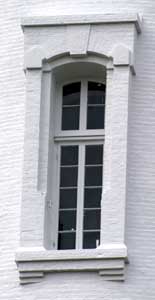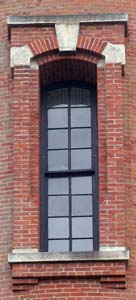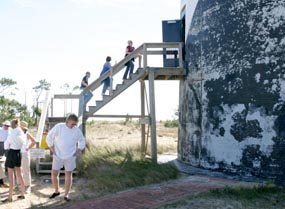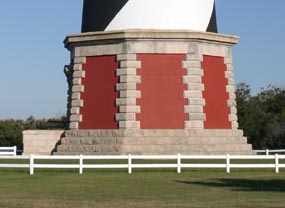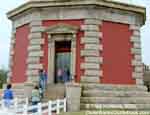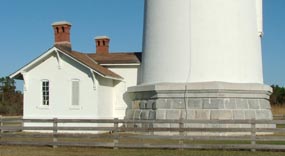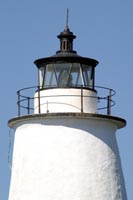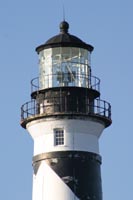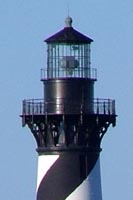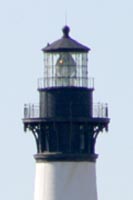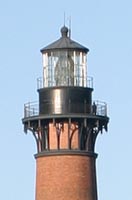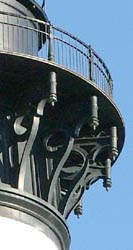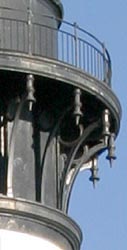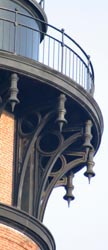 |
|||||||||||||||||||||||||||||||||||||||
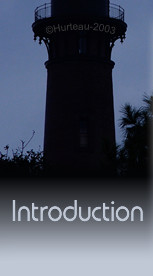 |
 |
||||||||||||||||||||||||||||||||||||||
North Carolina's Outer Banks boasts five lighthouses, or "light stations", which collectively attract hundreds of thousands of visitors each year (see author's note [1]). The buttons at right show the five lighthouses in order from north to south. Each button links you to the page(s) about the lighthouse it pictures. These navigation buttons will be on the left sidebar of each lighthouse page. The "Lighthouses" button in the top menu will bring you back to this main page. Here are some interesting facts. Among these five lighthouses:
It is easy to overlook the individualistic details of these inspiring lighthouses when actually confronted with the sheer size and grandeur of such amazing structures. The finer details of these architectural marvels usually go unnoticed by all but those visitors who come specifically because of their interest in architecture. Comparing details is difficult since the lighthouses are many miles apart. So to address that problem, the lighthouses are presented here, side by side, with some decidedly non-technical notes on a few of those often overlooked details. 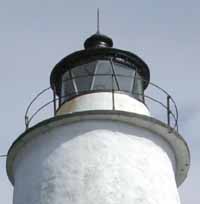 Of
the five, Ocracoke is the most strikingly different. It's the shortest
(beacon at 75 feet), and the oldest (completed 1823), and is constructed
of brick covered in cement or plaster (much like Bald Head Lighthouse
of that same era -1818). Its asymmetrical shape and off-center beacon
room (easily discernable in the photo at left) gives it a quaint crudeness
that befits its more humble height. Because of its complete uniqueness
among these five lighthouses, the rest of this page will focus on
the other four, which came later, and which took on decidedly different
proportions. Of
the five, Ocracoke is the most strikingly different. It's the shortest
(beacon at 75 feet), and the oldest (completed 1823), and is constructed
of brick covered in cement or plaster (much like Bald Head Lighthouse
of that same era -1818). Its asymmetrical shape and off-center beacon
room (easily discernable in the photo at left) gives it a quaint crudeness
that befits its more humble height. Because of its complete uniqueness
among these five lighthouses, the rest of this page will focus on
the other four, which came later, and which took on decidedly different
proportions.Much taller than any before it, the successful design of the current Cape Lookout Lighthouse, completed in 1859, became the model for the Cape Hatteras, Bodie Island and Currituck Beach lighthouses, which came after it. At 165 feet, Cape Lookout was much taller than its 95 foot high predecessor at the same site. This provided a more visible day marker, and a longer visible range for the beacon. The only problem was that the new Cape Lookout Lighthouse, and the first two patterned after it, each tall and slim and red bricked, looked too much alike by day. To remedy this, a paint scheme was devised so they could be easily identified from each other in daylight. But underneath the paint and beyond the general shape, there are other differences and similarities that are interesting. 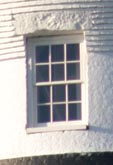 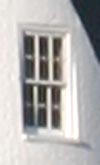 Windows - Cape Lookout (1859) has rather plain, simple windows, as shown here (left and right). If not for the curvature of the walls, they could easily be mistaken for normal house windows. The example at left is near the top of the structure, where the brick flares outward. It has a stone (or perhaps formed concrete) lintel to support the brick over the window. Note the roughness. This may be due to some damage (Civil War?), or perhaps just poor workmanship or poor materials. 
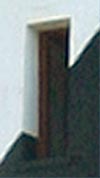 The first lighthouse built after the successful
model of the 1859 Cape Lookout Lighthouse was Cape Hatteras (1870).
The project forman was Dexter Stetson, whose fine work lives on, not
only in the Cape Hatteras Lighthouse, but in the two that followed
it. The tall slim, deeply recessed windows of Cape Hatteras (shown
at left) are not at all house-like, and look even plainer than those
of Cape Lookout. But the windows of Cape Hatteras Lighthouse were
not always quite so plain.
The first lighthouse built after the successful
model of the 1859 Cape Lookout Lighthouse was Cape Hatteras (1870).
The project forman was Dexter Stetson, whose fine work lives on, not
only in the Cape Hatteras Lighthouse, but in the two that followed
it. The tall slim, deeply recessed windows of Cape Hatteras (shown
at left) are not at all house-like, and look even plainer than those
of Cape Lookout. But the windows of Cape Hatteras Lighthouse were
not always quite so plain.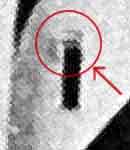 According to the Cape Hatteras Light Station
National Historic Landmark Study by Ralph Eshelman, each window originally
had a "granite pedimented hood".
According to the Cape Hatteras Light Station
National Historic Landmark Study by Ralph Eshelman, each window originally
had a "granite pedimented hood".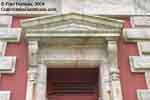 They were similar to the pediment
over the lighthouse door, just on a smaller scale. Evidence
of these hoods is clearly visible in the above right photo. An
1893
black and white photo of the lighthouse from NOAA archives shows
the "pedimented hood" over the windows as it was originally constructed.
While the photo is not extremely clear, the form is unmistakable in
this detail (at right) from the archive photo. But Eshelman states
that all of these hoods were "removed sometime after 1969". Close
inspection of the author's own 1973
photos of Cape Hatteras Lighthouse indicate the presence of only
a drip sill projecting from the base of each window. It is obvious
the ornate hood that was above each window was already gone by November
of 1973.
They were similar to the pediment
over the lighthouse door, just on a smaller scale. Evidence
of these hoods is clearly visible in the above right photo. An
1893
black and white photo of the lighthouse from NOAA archives shows
the "pedimented hood" over the windows as it was originally constructed.
While the photo is not extremely clear, the form is unmistakable in
this detail (at right) from the archive photo. But Eshelman states
that all of these hoods were "removed sometime after 1969". Close
inspection of the author's own 1973
photos of Cape Hatteras Lighthouse indicate the presence of only
a drip sill projecting from the base of each window. It is obvious
the ornate hood that was above each window was already gone by November
of 1973.Other design elements of the Cape Hatteras structure were very different from Cape Lookout, and will be covered farther along. As far as window design, the window treatments became even bolder when the next two lighthouses were constructed.
As mentioned, other cosmetic elements on later lighthouses changed drastically from the Cape Lookout design, while still retaining the tall proportions and general construction techniques it established. Here all four lighthouse bases are compared.
Another interesting area of design comparison is the top of these lighthouses. We'll begin with Ocracoke (right). It is completely different in all respects from the four later tall lighthouses. The beacon window frames use a pleasing diagonal astragal form, whereas the others all have rectangular window framing. Ocracoke has no lookout gallery below the beacon as do the others. At far right is shown Cape Lookout, which has a simple flared top to support the lookout gallery. Cape Hatteras, Bodie Island and Currituck Beach all have gingerbread brackets to support the gallery.
 Also note the main spindles in the Cape Hatteras gallery railing (left photo) are much more ornate than the simple cylindrical pipe verticals of Bodie Island, Currituck Beach or Cape Lookout. Note [1]- North Carolina has three other standing lighthouse structures which are not on the "outer" barrier islands and therefore are not included. They are Oak Island Light Station and Bald Head Lighthouse near Cape Fear, and the remains of a pre-civil war river range light on the Cape Fear River at Price's Creek. These may possibly be added to this web site at some later date. |
|||||||||||||||||||||||||||||||||||||||
| Navigate to individual
lighthouse pages with these buttons. Cape Lookout Lighthouse Open House dates |
|||||||||||||||||||||||||||||||||||||||
|
|||||||||||||||||||||||||||||||||||||||
| |
|||||||||||||||||||||||||||||||||||||||
